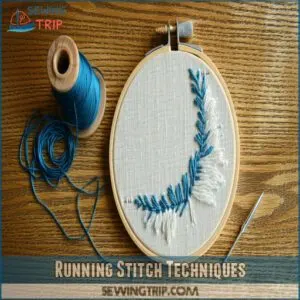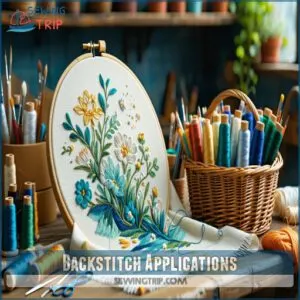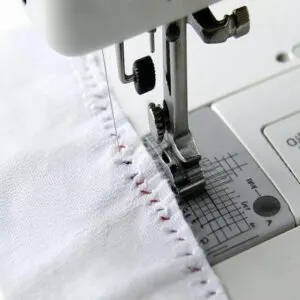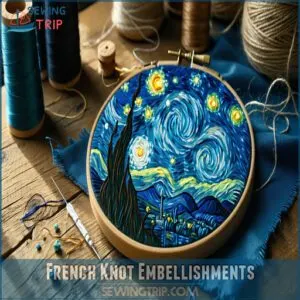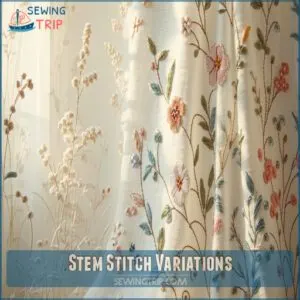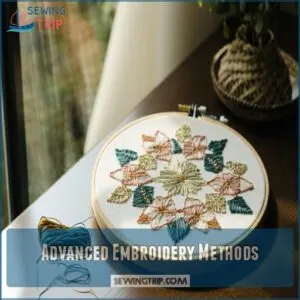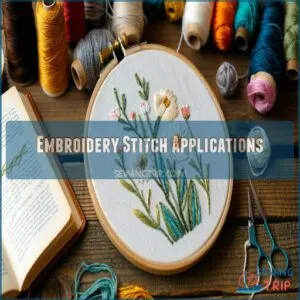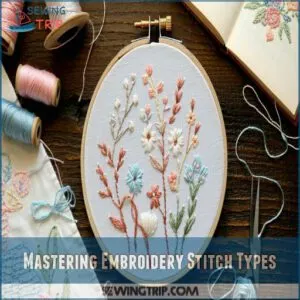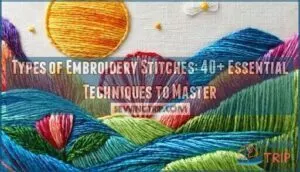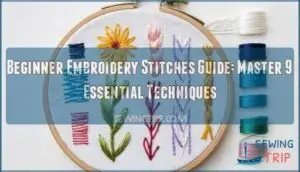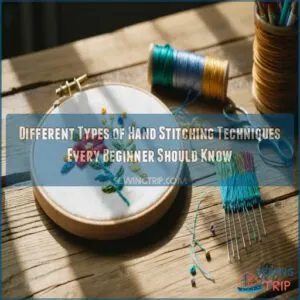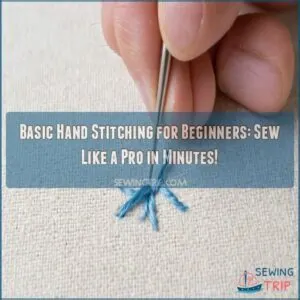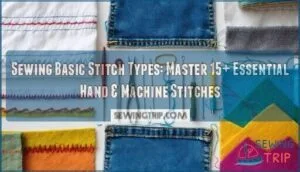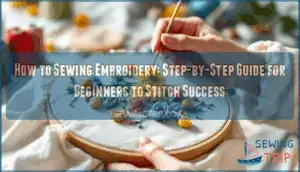This site is supported by our readers. We may earn a commission, at no cost to you, if you purchase through links.
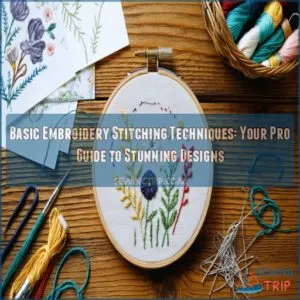
Start with the running stitch—perfect for outlining designs and controlling thread tension.
Next, use the backstitch for bold, clean lines or detailed lettering.
The straight stitch is versatile, helping you create stars, fills, or textured accents.
Want a touch of elegance?
Add French knots by wrapping thread around the needle to create beautiful, textured dots—think flowers or celestial patterns.
For curves and flow, the stem stitch is your go-to, ideal for vines or outlines.
Each technique opens up new creative possibilities—master these, and you’re ready for more intricate designs!
Table Of Contents
Key Takeaways
- You can master basic embroidery by starting with running stitches for outlines, backstitches for clean lines, straight stitches for texture, and French knots for beautiful dots.
- Practice controlling stitch tension, length, and spacing on scrap fabric for perfect results.
- Use the right tools: breathable fabric, embroidery hoop, needles, and cotton floss are key for beginners.
- Prevent thread tangling by using shorter lengths, unwinding twists as you work, and conditioning your threads when needed.
Basic Embroidery Stitches
Ready to transform your fabric into a canvas of creativity?
Master the art of basic embroidery stitches, and you’ll discover a world of stunning designs that’ll have everyone asking, "Did you really make that?
Running Stitch Techniques
A needle dancing through fabric tells the story of the running stitch—your first brushstroke in embroidery.
Master your running stitch by controlling stitch length and maintaining consistent thread tension.
Choose the right needle and fabric to elevate your technique.
Practice creates precision, transforming simple stitches into elegant lines that form the backbone of hand embroidery designs.
To achieve professional results, selecting the appropriate embroidery needles is essential for a smooth stitching experience.
Backstitch Applications
After mastering the Running Stitch, you’ll find Backstitch a game-changer for creating crisp, continuous lines in your embroidery projects.
This versatile technique lets you outline designs, add lettering, and create stunning embellishments with precision.
- Perfect for creating bold, unbroken lines
- Ideal for adding intricate details
- Supports multiple thread colors and styles
- Works beautifully on various fabric types
Backstitch tips can transform your embroidery from basic to breathtaking in just a few simple moves, making it a versatile technique for enhancing your projects.
Straight Stitch Uses
While we’ve explored the continuous lines of backstitch, let’s explore the versatile straight stitch for your embroidery projects.
You’ll find this basic embroidery stitch perfect for creating stars, scattered fills, and unique textures.
Here’s a quick guide to help you master different straight stitch effects:
| Effect | Thread Choice | Stitch Length |
|---|---|---|
| Stars | Pearl Cotton | 1/4 inch |
| Fill Pattern | Stranded Floss | 1/8 inch |
| Texture | Wool Thread | 1/2 inch |
| Scattered | Metallic | 3/8 inch |
French Knot Embellishments
Unlike simple straight stitches, French knots create gorgeous texture that’ll make your embroidery pop.
You’ll wrap your thread around the needle 2-3 times, then pull it through to form tiny, dimensional knots.
Try clustering these little beauties for flowers, adding stitch texture to tree bark, or creating starry night scenes.
They work best with smooth threads on medium-weight fabrics.
Stem Stitch Variations
Every stem stitch project opens up new creative doors when you play with variations.
Try adjusting your stitch length for different textures – shorter stitches create smooth curves, while longer ones add drama.
Mix thread colors for depth, or experiment with fabric choices that complement your design.
You’ll find stem stitch works beautifully for outlining flowers, creating vines, or adding delicate details to your embroidery projects, and it’s great for playing with variations to achieve unique effects, making it perfect for adding delicate details.
Intermediate Stitch Techniques
Now that you’ve got the basics down, let’s explore some fun intermediate embroidery stitches that’ll add flair to your work.
A thorough guide to hand embroidery stitches can help you master various techniques, from basic to advanced.
The Woven Wheel Stitch creates beautiful dimensional flowers – start with a star pattern, then weave your thread through for a stunning 3D effect.
Your thread choice really matters here.
Fabric tension is key when working with Chain Links and Feather Stitch.
These hand embroidery techniques require steady pressure and consistent stitch length for the best results.
The Chevron Stitch adds a sophisticated touch to borders – just remember to draw your guide lines first.
For a unique twist, try the Fly Stitch.
It’s like making tiny V’s that you can scatter across your fabric or line up in rows.
These intermediate embroidery stitches might take some practice, but they’ll seriously level up your embroidery stitch game.
A guide to hand embroidery stitches can help you master various techniques, from basic to advanced.
Advanced Embroidery Methods
You’ll discover how to create intricate designs using advanced techniques like the woven wheel stitch and bullion knots.
With these methods in your creative toolkit, you’ll transform simple fabric into stunning artwork that’ll make your friends ask "How did you do that?
Woven Wheel Stitch Tutorial
The woven wheel stitch creates beautiful floral patterns that’ll bring life to your embroidery.
Start by drawing a circle with an erasable pen and add at least 5 spokes from edge to center.
Your thread selection matters – use 6 strands for a plump, dimensional look.
Keep your stitch tension loose while weaving over and under each spoke, using embroidery tools like a tapestry needle with a blunt tip.
To master the stitch, understanding woven wheel embroidery is essential for creating stunning floral designs.
Couching Stitch Applications
The couching stitch opens up endless possibilities for your embroidery projects.
You’ll love how it lets you mix different threads and textures while maintaining perfect Thread Control.
Simply lay your chosen thread on the fabric’s surface and secure it with tiny stitches – it’s like creating a textured roadmap on your piece.
- Use metallic threads for holiday sparkle
- Create curved letters with yarn
- Design raised texture patterns
- Mix ribbons for 3D effects
- Build intricate border designs
The right Stitch Tension makes this basic embroidery stitch shine.
By choosing contrasting threads, you’ll add depth that turns simple patterns into eye-catching textile art.
Blanket Stitch Borders
Your embroidery project’s edges deserve that perfect finish, and the blanket stitch is your secret weapon.
This versatile border design works beautifully on any fabric choice, from delicate linens to sturdy cotton.
Master corner tips by adjusting your stitch length – try the closed blanket stitch for clean edges or the knotted blanket stitch for texture.
The double blanket stitch creates stunning borders, while blanket filling stitch adds depth to your work.
Bullion Knot Designs
While the bullion knot might seem tricky at first, this gorgeous stitch creates stunning floral designs that’ll make your projects pop.
Here’s what you need to nail those perfect knots:
- Choose a milliner’s needle with a slim shaft for smooth thread pulls
- Keep your stitch tensions consistent for even knots
- Match wrap counts to your desired knot length
- Practice different thread choices on scrap fabric first to ensure the best results with your stunning floral designs and achieve perfect knots.
Fly Stitch Patterns
While bullion knots create stunning roses, let’s explore a simpler yet equally beautiful technique.
The fly stitch (also called Y stitch) lets you create amazing patterns with minimal fuss.
You can work it horizontally or vertically to build unique textures – perfect for leaves and borders.
Try using contrasting thread colors and varying your stitch length for eye-catching designs.
It’s surprisingly versatile for basic embroidery stitches.
Mastering advanced embroidery techniques can help you create intricate designs and patterns with ease.
Embroidery Stitch Applications
You’ll discover endless ways to use your embroidery skills, from creating charming Valentine’s Day gifts to adding personal touches to your home decor.
Whether you’re stitching a cozy blanket border or crafting decorative wall art, you’ll find that each stitch type has its perfect place in bringing your creative vision to life.
Valentine’s Day Gift Ideas
Looking ahead to Valentine’s Day 2025, your basic embroidery stitches can create the most heartfelt gifts.
Try crafting personalized love tokens using a wooden embroidery hoop and herringbone cotton fabric.
For beginners, contemporary designs blend classic romance with modern aesthetics – perfect for creating unique Valentine crafts.
Add romantic symbols to gift wrapping, or stitch custom love-themed embroidery pieces that’ll mean more than store-bought cards.
Decorative Embroidery Details
Beyond Valentine’s hearts, you’ll find countless ways to add sparkle to your projects with decorative embroidery stitches.
Mix thread colors and stitch textures to create eye-catching design elements – think tiny French knots for flower centers or backstitches for delicate vine patterns.
Your fabric choices matter too; lighter weaves show off embellishment ideas better, while heavier materials work great for bold, textured patterns.
Mastering basic embroidery stitches is essential for creating intricate and beautiful designs that elevate your style with beautiful designs.
Stitch Variations for Gifts
Your personalized textiles deserve special stitch variations that make each gift uniquely meaningful.
Take your basic embroidery stitch instructions to the next level with these creative gift embellishments.
Considering unique embroidery stitch gifts, such as those found in embroidery stitch gifts, can inspire new project ideas.
- Mix minimalist outline designs with vibrant thread colors for modern monograms
- Combine machine and hand-stitched details for texture-rich custom designs
- Create eco-friendly stitched ornaments using organic materials
- Add metallic thread accents to fabric gifts for extra sparkle
- Layer simple geometric patterns with decorative embroidery stitches
Embellishments for Home Decor
Moving from gift embellishments to home decor, you’ll find endless ways to spruce up your living space with fabric art.
Let’s explore how different embroidery techniques and materials can transform everyday items into stunning textile designs.
| Embellishment | Perfect For |
|---|---|
| Beads | Table Runners |
| Sequins | Throw Pillows |
| Metallic Threads | Wall Hangings |
| Outline Stitch | Napkin Edges |
| Raised Knots | Curtain Borders |
Home accents shine when you combine decorative threads with hand embroidery techniques.
Whether you’re jazzing up tablecloths or adding flair to curtains, embellished fabrics bring personality to any room.
Mastering Embroidery Stitch Types
You’ll discover the essential embroidery stitches that transform simple fabric into beautiful artwork, from basic running stitches to eye-catching French knots.
With each stitch type you master, you’re adding another tool to your creative toolkit that’ll help you bring your embroidery designs to life, using techniques like the embroidery stitches.
Satin Stitch Filling Techniques
Every satin stitch you create builds a luxurious smooth surface of parallel threads.
This versatile filler stitch transforms flat fabric into dimensional art, with each thread laying snugly against its neighbor.
Mastering the satin stitch technique is essential for achieving professional-looking embroidery.
- Keep your thread tension consistent and gentle to avoid fabric puckering
- Work your filling patterns gradually around curves, adjusting angles for smooth flow
- Consider adding padding underneath for raised, dramatic texture effects
Leaf Stitch Designs
Transform ordinary fabric into a garden of possibilities with the versatile leaf stitch that brings nature’s beauty to life.
You’ll master floral motifs using varied green threads and stitch textures that create depth and movement.
The following table outlines different design and texture types for embroidery:
| Design | Texture Type | Perfect Use |
|---|---|---|
| Fern | Light, Feathered | Borders |
| Padded | Dense, Layered | Focal Points |
| Free-style | Loose, Natural | Accents |
To ensure the best results, test your nature inspirations on scrap canvas first—this simple embroidery technique trick saves frustration later, and allows you to practice with varied green threads and floral motifs.
Chain Stitch Variations
The timeless chain stitch opens up a world of creative possibilities.
Play with stitch length and thread colors to create unique patterns – from basic embroidery stitches to modern twists.
Try the twisted chain stitch for texture, or explore the magic chain stitch for bold outlines.
Your fabric choice matters: medium-weight fabrics work best for these embroidery stitch variations.
Lazy Daisy Embroidery
The lazy daisy stitch brings flower patterns to life with minimal fuss.
You’ll start with a simple loop anchored at its tip – like a basic embroidery stitch that’s caught taking a nap.
When you’re working with embroidery threads, keep your stitch tension even as you create each petal.
Choose medium-weight fabric for the best results, and you’ll soon have a garden of lazy daisy flower embroidery blooming on your hoop.
Advanced Stitch Combinations
Looking to level up your embroidery game? Mix satin and running stitches to create stunning contrast between glossy and matte finishes.
Try thread blending with different weights for depth, or layer stitches for unique textures.
For even more advanced techniques, explore learning advanced embroidery techniques like stumpwork or goldwork to add three-dimensional elements.
Combine fill stitches with creative stitch combinations to add dimension, and your fabric manipulation skills will shine when you master these decorative embroidery techniques for composite designs.
Frequently Asked Questions (FAQs)
What is the easiest embroidery technique?
The easiest embroidery technique is the Running Stitch.
It’s as simple as weaving a needle in and out of fabric in a straight line.
Think of it like doodling, but with thread—totally beginner-friendly!
What are the 5 basic stitches?
Embroidery’s core stitches are like your trusty toolkit: running stitch for outlines, backstitch for bold lines, straight stitch for textures, French knot for tiny pops, and stem stitch for smooth curves.
Master these first!
How to learn basic embroidery stitches?
Start with simple stitches like Running Stitch or Backstitch.
Practice on scrap fabric, using online tutorials or embroidery books for guidance.
Consistency, patience, and repetition are key to building confidence and mastering the basics.
What is the formula for embroidery stitches?
Think of embroidery stitches like a recipe—there’s no rigid formula, but the “ingredients” are thread, fabric, and technique.
Practice stitch lengths, spacing, and tension to master beautifully even, creative designs with your personal style.
How do you prep fabric for embroidery?
Grab breathable fabric, give it a good press to remove wrinkles, and secure it tightly in a hoop.
Don’t skip stabilizer if needed—it keeps stitches neat.
Wash your hands first to avoid stains!
What tools are essential for beginners?
Picture sitting with fabric in hand – you’ll need needles, embroidery hoops, fabric scissors, and thread.
Add an erasable fabric pen for designs.
A thimble’s handy too if needlework starts giving your fingers attitude!
How do you transfer patterns to fabric?
To transfer patterns, you can trace them with a water-soluble pen, use iron-on transfer paper, or employ carbon transfer paper.
Each method works wonders—just pick one that suits your fabric and project best.
What thread types work best for projects?
Choose cotton embroidery floss for most projects—it’s versatile and affordable.
Pearl cotton adds texture, while metallic threads bring sparkle.
For delicate details, silk threads shine. Match thread type to your fabric and design for the best results.
How do you prevent thread tangling?
Tangled thread’s like a bad hair day—frustrating but fixable.
Use shorter thread lengths, avoid rapid pulling, and let your needle hang occasionally to unwind twists.
Try beeswax or thread conditioners for smoother stitching.
Conclusion
Think of mastering basic embroidery stitching techniques as planting seeds in a garden.
Each stitch—running, back, or French knot—is a step toward creating something uniquely yours.
With practice, your designs will bloom into intricate, beautiful creations, whether you’re adding texture, making gifts, or sprucing up home decor.
Don’t rush—enjoy the process, and watch your skills grow, as embroidery isn’t just art; it’s your story stitched one thread at a time.
Try it today and see the magic unfold!
- https://www.thesprucecrafts.com/stitches-every-embroiderer-should-know-4122123
- https://aprettyfix.com/7-basic-embroidery-stitches-beginners/
- https://www.dmc.com/GB/en-GB/sbs-embroidery-stitch-diagrams
- http://www.molliemakes.com/stitch-library/library-embroidery-stitches/
- https://tatasol.com/6-basic-embroidery-stitches-for-beginners/

